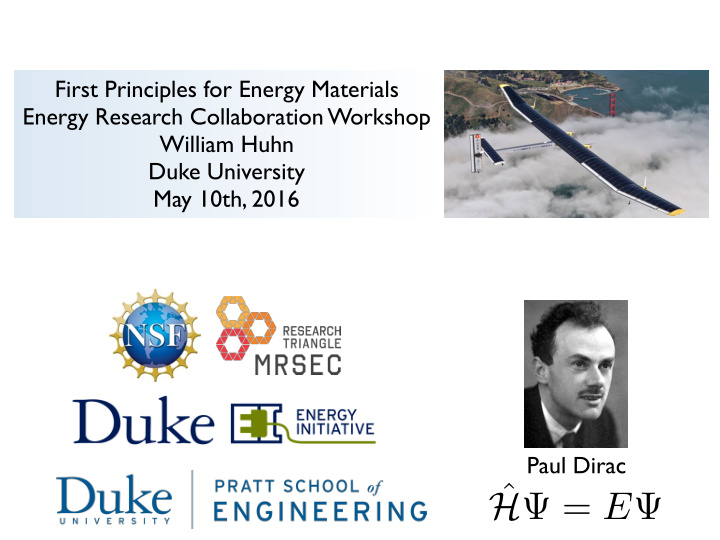



First Principles for Energy Materials Energy Research Collaboration Workshop William Huhn Duke University May 10th, 2016 Paul Dirac ˆ H Ψ = E Ψ
The FHI-aims Group at Duke Volker Blum Tong Zhu Group Leader PV Materials Lead, FHI-aims Project William Huhn Garnett Liu Spin-Orbit Coupling Perovskites “Photovoltaics Lead” Ab Initio Materials Simulations Group Hudson Hall, Duke University Formerly: Björn Lange Raul Laasner Victor Yu Jan Kloppenburg Nuclear Spin States Electronic Structure Tiago Botari NMR Infrastructure (NSF)
Photovoltaic Materials Si 25% efficiency Standard material for PV
Photovoltaic Materials III-V Si Al P Ga As In Sb 25% efficiency 48% efficiency! Standard material Expensive and for PV difficult to grow
Photovoltaic Materials III-V Si CdTe Al P Ga As In Sb 25% efficiency 48% efficiency! 23% efficiency Standard material Expensive and Contains toxic for PV difficult to grow elements
Photovoltaic Materials Can we find non-toxic, (relatively) cheap new materials in this class? III-V Si CdTe Al P Ga As In Sb 25% efficiency 48% efficiency! 23% efficiency Standard material Expensive and Contains toxic for PV difficult to grow elements
Earth-Abundant, Non-Toxic Photovoltaics David Mitzi Cu-Zn-Sn-S (12%) Non-toxic and (relatively) cheap!
Earth-Abundant, Non-Toxic Photovoltaics David Mitzi Bayram Saparov Cu-Ba-Sn-S Cu-Zn-Sn-S (12%) Non-toxic and (relatively) cheap!
Earth-Abundant, Non-Toxic Photovoltaics David Mitzi Bayram Saparov Tong Zhu Cu-Ba-Sn-S Cu-Zn-Sn-S (12%) Non-toxic and (relatively) cheap!
Earth-Abundant, Non-Toxic Photovoltaics David Mitzi Bayram Saparov Tong Zhu Cu-Ba-Sn-S Cu-Zn-Sn-S (12%) Non-toxic and Cu-Ba-Sn-Se (relatively) cheap!
Hybrid Organic-Inorganic Perovskites Eames et al., Nature Comm. 2015 CH 3 NH 3 PbI 3 Efficiency increased from 12% to 20.1% in only 2 years!
Hybrid Organic-Inorganic Perovskites David Mitzi Yosuke Kanai (UNC) Eames et al., Nature Comm. 2015 CH 3 NH 3 PbI 3 AEQTPbBr 4 Efficiency increased from Garnett Liu Moving to a 2D layered material 12% to 20.1% in only 2 years! allows for much larger molecules, improved tunability
Prediction of Design Parameters with First Principles AEQT -PbBr 4 - no SOC
Prediction of Design Parameters with First Principles AEQT -PbBr 4 - no SOC AEQT -PbBr 4 - SOC
Prediction of Design Parameters with First Principles AEQT -PbBr 4 - no SOC AEQT -PbBr 4 - SOC
Prediction of Design Parameters with First Principles AEQT -PbBr 4 - no SOC AEQT -PbBr 4 - SOC Holes on organic component, electrons on inorganic component? ... good principle for PV (carrier separation)
Prediction of Design Parameters with First Principles AEQT -PbBr 4 - no SOC AEQT -PbBr 4 - SOC Holes on organic component, electrons on inorganic component? ... good principle for PV (carrier separation) First principles reveals spin-orbit coupling is an important design choice to consider
First Principles for Energy Materials
Photovoltaic Efficiency Over Time
Recommend
More recommend